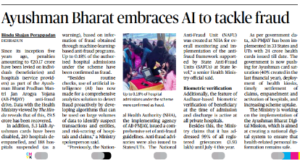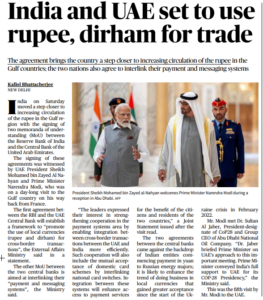Topic 1: Healthcare and Artificial Intelligence
GS 2 : Issues relating to development and management of Social Sector/Services relating to Health, Education, Human Resources.
GS 3: Science and Technology- developments and their applications and effects in everyday life

Introduction:
- The Ayushman Bharat Pradhan Mantri Jan Arogya Yojana (AB-PMJAY) has been operating for five years and has taken significant steps to combat fraud in the system.
- Leveraging artificial intelligence (AI) and machine learning-based anti-fraud programs, the Health Ministry has made substantial progress in detecting and preventing fraudulent activities in the healthcare scheme.
AI-Powered Analytics for Fraud Detection:
- The Health Ministry has integrated artificial intelligence into the system, enabling comprehensive analytics to detect fraudulent practices proactively.
- By developing sophisticated algorithms, the program can analyse large volumes of data and identify suspicious transactions and entities.
- This includes risk-scoring of hospitals and claims, allowing for the early detection of potential fraud.
Implementation of Anti-Fraud Measures:
- In addition to AI-driven analytics, the National Health Authority (NHA), which is the implementing agency of AB-PMJAY, issued a set of comprehensive anti-fraud guidelines.
- Anti-fraud advisories were also provided to States/UTs to raise awareness and ensure uniformity in tackling fraudulent activities.
- The creation of the National Anti-Fraud Unit (NAFU) at NHA, supported by State Anti-Fraud Units (SAFUs) at the state level, helps in monitoring and implementing the anti-fraud framework effectively.
Aadhaar-Based Biometric Verification:
- To further enhance the authenticity of beneficiaries and prevent misuse, the scheme introduced Aadhaar-based biometric verification at the time of admission and discharge in all private hospitals.
- This biometric verification process ensures that only genuine beneficiaries can avail of the scheme’s benefits, reducing the likelihood of fraudulent claims.
Impact of AI on Fraud Reduction:
- Over the past five years, penalties totalling ₹17 crore have been levied on individuals and hospitals involved in fraudulent activities.
- Of this amount, ₹5 crore has been successfully recovered.
- Furthermore, 5.3 lakh Ayushman cards have been disabled, and 210 hospitals have been de-empanelled due to their involvement in fraud.
- Additionally, 188 hospitals have faced temporary suspension as a warning against fraudulent practices.
Fraud Confirmation Rate and Grievance Redressal:
- The data reveals that up to 0.18% of authorized hospital admissions under the scheme have been confirmed as fraudulent, indicating the success of the AI-powered anti-fraud measures in identifying and stopping fraudulent activities.
- Moreover, the Ministry has addressed a significant number of grievances, resolving 99% of the registered complaints (3.93 lakh) by July 4 this year, indicating the efficiency of the scheme’s grievance redressal process.
Future Initiatives and Ayushman Bharat Digital Mission:
- The government continues to focus on expanding the AB-PMJAY scheme’s coverage and uptake by implementing Ayushman Bharat Digital Mission.
- This mission aims to create a national digital system to maintain health-related personal information securely.
- With the ongoing success of AI-powered anti-fraud measures, the Ministry remains committed to ensuring the scheme’s integrity and enhancing healthcare accessibility for the masses.
Conclusion:
The Ayushman Bharat Pradhan Mantri Jan Arogya Yojana has successfully integrated AI-powered analytics to detect and deter fraudulent activities within the scheme.
The use of artificial intelligence has led to the recovery of penalties, deactivation of fraudulent cards, and suspension of unscrupulous hospitals.
The government’s proactive approach, supported by advanced technology, is making healthcare more accessible and reliable for millions of beneficiaries across India.
Topic 2 : India and UAE set to use rupee, dirham for trade
GS 2: Bilateral, regional and global groupings and agreements involving India and/or affecting India’s interests

Introduction
India and the Gulf region took significant steps to increase the circulation of the rupee in the area through the signing of two Memoranda of Understanding (MoUs) between the Reserve Bank of India (RBI) and the Central Bank of the United Arab Emirates (UAE).
The signing ceremony, witnessed by UAE President Sheikh Mohamed bin Zayed Al Nahyan and Indian Prime Minister Narendra Modi during his day-long visit to the Gulf country, aimed to strengthen financial cooperation and facilitate cross-border transactions.
1.Promotion of Local Currencies
- The first agreement established a framework to promote the use of local currencies, specifically the rupee and dirham, for cross-border transactions.
- This move is expected to bolster economic ties between India and the UAE by reducing dependency on foreign currencies and enhancing the stability and flexibility of their financial systems.
- Integration of Payment Systems
- The second MoU focused on interlinking the payment and messaging systems of both central banks.
- By facilitating more efficient cross-border transactions between India and the UAE, this integration is set to enhance access to payment services for citizens and residents of both nations. It also includes mutual acceptance of domestic card schemes, further streamlining financial transactions.
- Strengthening India-UAE Relations
- The joint statement issued after the visit expressed the leaders’ interest in strengthening cooperation in the payment systems area, which would facilitate more seamless and secure financial interactions between the two countries.
- This move reflects a shared commitment to fostering economic growth and mutual benefits for citizens and businesses in India and the UAE.
- Advancing Regional Currency Usage
- The agreements between the central banks come in the context of Indian entities starting payments in yuan to Russian energy majors.
- This development suggests a growing trend of conducting business in local currencies, gaining momentum since the Ukraine crisis in February 2022.
- By promoting the use of local currencies, India and the Gulf region aim to enhance their economic resilience and reduce the impact of external factors on their financial systems.
- Support for UAE’s COP-28 Presidency
- During the visit, Prime Minister Narendra Modi met with Dr. Sultan Al Jaber, President-designate of COP-28 and Group CEO of Abu Dhabi National Oil Company.
- India conveyed its full support to the UAE for its COP-28 Presidency, further reinforcing bilateral ties and cooperation between the two countries.
Overall, the agreements signed during Prime Minister Modi’s visit to the UAE mark a significant step towards increasing the circulation of the rupee in the Gulf region. These developments are expected to boost economic collaboration, strengthen financial systems, and foster closer ties between India and the UAE.
Topic 3: Climate change and its deteriorating multiplier effects
GS 3: Conservation, environmental pollution and degradation, environmental impact assessment.

Main findings of the article
- A modelling study published in Nature Sustainability estimated the annual changes in cooling degree days (CDDs) if the global mean temperature rises from 1.5 degree C to 2 degree C above pre-industrial levels.
- CDDs compare the mean outdoor temperature of a region to a standard baseline temperature (18 degree C) to determine temperature exposure and cooling requirements.
- The study found that regions surrounding the Equator, particularly the sub-Saharan countries, would have the greatest increase in cooling demand.
- The study also found that countries in the Global North, especially European nations, would experience the largest relative increase in cooling needs, as they are unprepared for high temperatures and will require large-scale adaptation to heat resilience.
Implications
- Rising temperatures are already driving cooling demand, and it has been estimated that by 2050 the energy required by cooling could be the equivalent of the combined electricity capacity of the U.S., the European Union and Japan in 2016, as reported by the International Energy Agency (IEA).
- The Paris Agreement aims to limit the rise in the global mean temperature to 1.5 degree C, but there are still uncertainties regarding when and how these temperature increases will occur across different countries and the role that changes in other parameters, such as humidity, will play.
- The study concludes that even small changes in temperatures will affect heat exposure and cooling demand, driving the need for immediate and unprecedented adaptation interventions worldwide to be prepared for a hotter world.
Adaptation Interventions
- Cool roofs: These are technologies that increase the surface reflectance of buildings to deflect more incoming solar radiation and reduce the heat absorbed by the buildings. They can lower the indoor temperature and the cooling energy demand of buildings.
- Improved building design: This includes measures such as insulation, shading, natural ventilation, passive cooling, and thermal mass that can enhance the thermal performance and comfort of buildings and reduce the reliance on mechanical cooling systems (Khosla et al. 2021b).
Efficient cooling systems: These are technologies that can provide cooling services with less energy input and lower greenhouse gas emissions, such as fans, evaporative coolers, heat pumps, district cooling, and solar cooling.
Topic 4: Himalayas under threat

GS 1 : Important Geophysical phenomena such as earthquakes, Tsunami, Volcanic activity, cyclone etc., geographical features and their location-changes in critical geographical features (including water-bodies and ice-caps) and in flora and fauna and the effects of such changes.
GS 3 : Conservation, environmental pollution and degradation, environmental impact assessment.
GS 3 : Disaster and disaster management.
Introduction:
- Himachal Pradesh, known as the abode of gods, is facing an increasing threat from natural calamities like floods, droughts, glacial lake outbursts, and landslides.
- These mishaps have intensified over the years, causing immense damage to infrastructure and livelihoods in the region.
- The impact of erratic climatic conditions is particularly devastating to horticulture, agriculture, and the tourism industry.
- The lack of environmentally-friendly development practices and the inadequate implementation of measures by authorities have exacerbated the situation.
Devastating Floods and Landslides:
- The recent floods in Beas have severely affected areas around Manali, Kullu, and Mandi, resulting in several deaths and massive infrastructure damage.
- Chamba’s Bharmour region has been cut off due to the Ravi river’s overflow, washing away a part of the main road.
- The excessive construction of hotels and dhabas near riverbeds has worsened the situation, as they were easily swept away by the floods.
- The Larji and Pandoh dams’ water release led to the devastating loss of many houses in Pandoh, exposing the failure of these dams to control floods as originally claimed.
Unfulfilled Proposals for Sustainable Development:
- In 1992, a committee under SZ Qasim recommended an environment-friendly development model for the region, but no significant action followed.
- The Niti Aayog formed a regional council for Himalayan states to ensure sustainable development, but its effectiveness on the ground remains questionable.
- Thematic reports and action points identified by the Niti Aayog in 2018 aimed at river basin development, water security revival, tourism standards implementation, and skill and entrepreneurship strengthening have yet to yield tangible results.
The Importance of Green Cover and Environmental Activities:
- Himachal Pradesh faces a financial burden and has sought a special package to preserve its green cover while meeting expenditure needs.
- Although the state enjoys a reduced share in Centre-initiated projects, central schemes often fail to address local requirements adequately.
- A crucial step towards sustainable development lies in defining prohibited activities in the Himalayan region and promoting environmentally-friendly alternatives to minimize environmental damage.
Conclusion:
Himachal Pradesh’s vulnerability to natural calamities and the escalating impact on livelihoods necessitate immediate action towards sustainable development.
Implementation of environment-friendly measures, effective utilization of resources, and a collaborative approach between the government, local communities, and stakeholders are crucial to ensure the well-being of the region and its inhabitants.

